Tom’s Guide is supported by its audience. When you purchase through links on our site, we may earn an affiliate commission. Learn more
By published
Will an ink subscription really save you money? We compared offerings from Canon, HP, Epson and Brother to find out how much.
The desire to save money on printing is nothing new. Replacing a printer’s ink cartridges gets expensive in the long run. To ease the pain, some printer models offer high-yield cartridges, which offer some savings. A new strategy to reduce ongoing ink costs is with an ink cartridge subscription plan. All the major printer manufacturers now offer some variation of this.
When the ink in your printer is running low, these services automatically order and ship ink cartridges to you. This is undoubtedly convenient, saving you a trip to the office supply store.
Convenience aside, the big question is, will an ink subscription really save you money? That’s what we set out to determine for this story.
We compared plans from the four biggest inkjet printer brands: Brother, Canon, Epson and HP. The plans vary and offer different terms, so you’ll want to match your printing needs to the right plan in order to maximize your savings.
These days, every printer manufacturer offers some sort of ink subscription plan. For a small recurring fee, you get to skip the inconvenience of running out of ink in the middle of a printing project, and save yourself a trip to the store, all while giving printer companies a new way to encourage brand loyalty and keep more dollars from going to third-party budget ink sellers.
Some plans have a monthly fee that includes a set number of printed pages, and the option to buy extra pages. Other plans simply offer a discount on the automatically triggered ink purchases, or just free shipping.
When the ink in your printer is running low, these services automatically order and ship ink cartridges to you. This is undoubtedly convenient, saving you a trip to the office supply store. In most cases, the shipping will be free, and you will receive an email notification that the order has been placed. Generally, you will have 24 hours to cancel the order, just in case you don’t really need it. The printer needs to be connected to the internet for these subscription services to work.
All of these plans automatically ship ink cartridges to you when your printer is running low. The printer must be connected to the internet to initiate the order. And, of course, the printer must be eligible for the subscription plan. In our research, we found that most inkjet printers and all-in-ones we have tested are eligible for the manufacturer’s ink subscription plan—but not all of them.
There are two types of ink subscriptions. Those with a monthly fee allow you a set number of printed pages. You pay only the monthly fee, not for the ink cartridges themselves when they are shipped to you.
An ink subscription with a monthly page count may be best suited to users with a consistent print volume. If your print needs vary widely, you may have to monitor your ink subscription plan in order to avoid excessive purchases of extra pages, or to avoid losing excessive pages that have been rolled over from previous months when you printed less than your plan allows.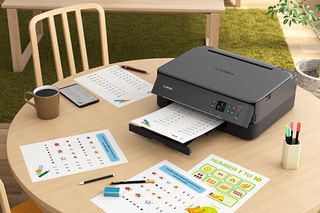
Regardless of the type of plan, the ink shipment is triggered automatically, and you are sent a notice, which gives you the option to cancel.
In some cases, third-party ink ordering programs are done in partnership with the printer makers. For example, Amazon Smart Ordering is offered by Brother.
If you already own a printer by HP, Brother or Epson, you have only one type of plan to choose from. Interestingly, Canon offers both types of ink subscription plans—but at press time only a couple models were eligible for its Pixma Print plan, which comes with a monthly fee and a set number of pages.
For this story, we evaluated ink subscription services for personal/small office inkjet printers. The majority of inkjet printers tested by Tom’s Guide have a standard black ink cartridge that will print an estimated 1,000 pages or less. For these models, the average costs per page are 7.7 cents (text) and 20.7 cents (color). When using high-yield cartridges, these averages go down to 5.9 cents and 14.9 cents per page, respectively.
Both Canon and HP offer this type of plan, with page-count tiers. Both plans offer extra pages for 10 cents each, and a limited number of rollover pages. We have calculated the cost per page for the plans, assuming you printed exactly the monthly limit.
For these models, the average costs per page are 7.7 cents (text) and 20.7 cents (color). When using high-yield cartridges, these averages go down to 5.9 cents and 14.9 cents per page, respectively.
Basic cartridge replacement plans generally offer a set discount over retail pricing, but the amount varies by manufacturer. Even on those plans without special savings, you’ll get free shipping and the added convenience of one less trip to the store when you run out of ink.
Arguably the most popular and widely known ink subscription plan is HP Instant Ink, which offers a monthly fee-type plan that lets users pick the plan that matches their regular printing needs, and sends cartridges in the mail just when you need a refill.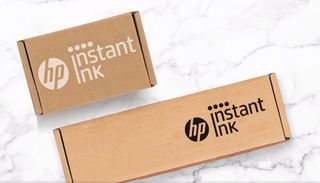
If you use all of your pages, your cost per page will be anywhere from 4 cents to 7 cents. Extra pages cost $1 for 10, or 10 cents each. You are allowed to roll over up to three times the number of pages in your monthly plan.
By comparison, the Envy 7855 has costs per page of 7.1 cents (text) and 18 cents (color) when using high-yield cartridges. The printer uses two cartridges: black and tri-color.
If you used all your pages in the Occasional plan that comes with 50 pages per month, your cost per page would be 6 cents, regardless of how much color you printed. At that rate, Instant Ink looks like a pretty good bargain. Upping your plan to 100 pages per month would drop your cost per page to 5 cents.
Verdict: If you don’t let rollover pages expire, it’s a pretty good bet you’d save money with HP Instant Ink.
Canon Pixma Print is one of two ink subscription plans offered for Canon printers, and uses the monthly page count approach, charging a monthly fee for an allotted number of pages, and then shipping fresh ink whenever the printer is running low.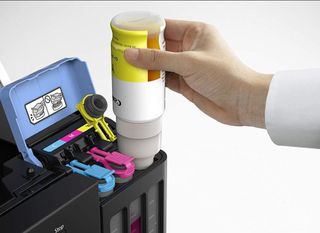
One plan, Pay As You Print, limits you to 30 pages and does not offer extra page purchases or allow you to rollover unused pages. The other Canon plan tiers offer extra pages for 10 cents each, as well as rollover pages. Shipping is free.
Costs per page range from 5 cents to 17 cents, if you were to use all your pages. However, at press time, only two models were eligible for this plan: the Pixma TS6420 ($100) and Pixma TR7020 ($130). (To check the list of eligible models, see Canon’s website.) Both models use two ink cartridges: one black, and one tri-color.
One important detail is rollover pages. Comparing each company’s 100-page plan, HP allows customers to roll over up to 300 pages, while Canon limits you to 100 rollover pages. However, Canon does include 100 free pages in its plan, which are good for six months.
Without this plan, printing 4-by-6-inch color photos with the two eligible models costs 37.1 cents using standard cartridges, and 28.9 cents with high-yield cartridges. If you print photos almost exclusively, even the entry-level plan would save you a chunk of change, at 17 cents per print. At the highest volume, the 200-pages-per-month Frequent plan drops cost per print to just 5 cents. This assumes, of course, that you are able to use all your pages, and never lose any pages you roll over. It also assumes you never go over and have to pay 10 cents per extra print.
Verdict: The Canon Pixma Print plan can certainly save you money if you keep up with the plan’s page count. However, only two models are currently eligible.
Brother Refresh offers a 5 percent discount on ink cartridges. There is no monthly fee, and you can cancel at any time without penalty. To enroll, you select either Brother or Amazon Smart Order as the fulfillment provider. You can use the Brother PrinterProPlus app to enroll in Refresh, check ink levels, and manage your account.
When you enroll, you select whether you want standard, high-yield, or super high-yield cartridges to be ordered. Standard shipping is free to the continental U.S., for orders over $20. Shipping on smaller orders costs $5.75. After an order is placed automatically, the customer receives an email notification. You have 24 hours to cancel the order.
Unlike previously mentioned printers, the Brother MFC-J995DW that we tested already offers very low costs per page. Using high-yield cartridges, the MFC-J995DW offers low costs per page of 1 cent (text) and 5 cents (color). These cartridges print an estimated 6,000 and 5,000 pages each, respectively. Signing up for this automatic ordering will save you five percent, and the shipping will always be free because even one standard yield ink cartridge for this model costs more than the minimum for free shipping.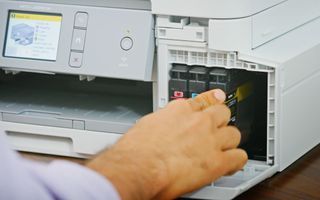
Verdict: Brother’s high-yield printers are known for low costs per page already. Saving another 5 percent is a no-brainer.
Canon’s Auto Replenishment service offers free enrollment and free standard shipping on ink purchases. When your printer displays a low ink message, replacement cartridges will be ordered and an order confirmation email will be sent. Free standard shipping takes three to seven days, according to Canon.
Canon does not offer a set discount with its plan, which is disappointing. However, you will receive a discount if a promotional discount is being offered when your order is placed.
Of the Canon printers we’ve tested in this category, they averaged costs per page of 8.9 cents (text) and 22.1 cents (color) with standard cartridges, and 7 cents (text) and 16 cents (color) when using high-yield cartridges.
You can find a list of eligible printers on the Canon website.
Verdict: Canon’s Auto Replenishment subscription does not offer a set discount, so the benefit is more for convenience than cost savings.
Epson does not offer an ink cartridge subscription directly. Rather, its ReadyInk program directs customers to enroll via a third-party ink subscription plan from Amazon or Staples. Both companies offer automatic ordering of ink cartridges, triggered by an eligible printer. (See the list of eligible printers on the Epson ReadyInk website.)
Both Amazon Dash and Staples Smart Ordering offer a 10 percent discount on ink purchases. Amazon Dash does not require an Amazon Prime membership. For Prime members, using Amazon Smart Ordering adds Alexa functionality with the printer. As with previously discussed plans, ink cartridge orders are triggered when the printer detects it is low on ink.
Amazon Dash offers free shipping if the product is eligible for free shipping. Staples Smart Ordering offers free shipping on every order.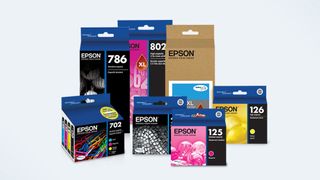
For comparison, the Epson WorkForce WF-2760, which we reviewed, offers costs per page of 6 cents (text) and 17.3 cents (color), when using its high-yield ink cartridges. Getting a 10 percent discount and free shipping knocks that down to 5.4 cents and 15.6 cents, respectively.
Verdict: Epson’s ReadyInk subscription will save you 10 percent on ink purchases, and Amazon Prime members can take advantage of Alexa integration on compatible printers.
Which type of ink subscription is right for you depends on how consistent your print volume is. Whether you have the stomach for managing an ink subscription with a monthly page count, to make sure you don’t leave money on the table, is a largely personal decision. If managed well, a page count plan can certainly save you money.
On the other hand, a subscription plan that offers a set discount on ink sounds like a no-brainer. With a set discount on ink purchases, which arrive automatically as with the page count plans, you know you’re saving money without having to take any action whatsoever.
Whichever type of plan you choose, it appears the printer makers are offering a fair amount of flexibility. In one form or another, these plans allow you to change your page count, buy extra pages, carry over unused pages, pause the subscription, cancel an unneeded order, or cancel the service without penalty. No matter which variety you decide on, it’s pretty certain you’ll be able to lower your printing costs.
Eric Butterfield is a freelance writer and musician from California. His work has appeared in PC World magazine, CNET, Taproot, and Alter Action — plus Tom’s Guide, of course — while his music has appeared in more than 260 TV show episodes for major networks such as NBC, Hulu, BBC America, and more. You can check out his work on Spotify.
Get instant access to breaking news, the hottest reviews, great deals and helpful tips.
Thank you for signing up to Tom’s Guide. You will receive a verification email shortly.
There was a problem. Please refresh the page and try again.
Tom’s Guide is part of Future US Inc, an international media group and leading digital publisher. Visit our corporate site.
© Future US, Inc. 11 West 42nd Street, 15th Floor, New York, NY 10036.